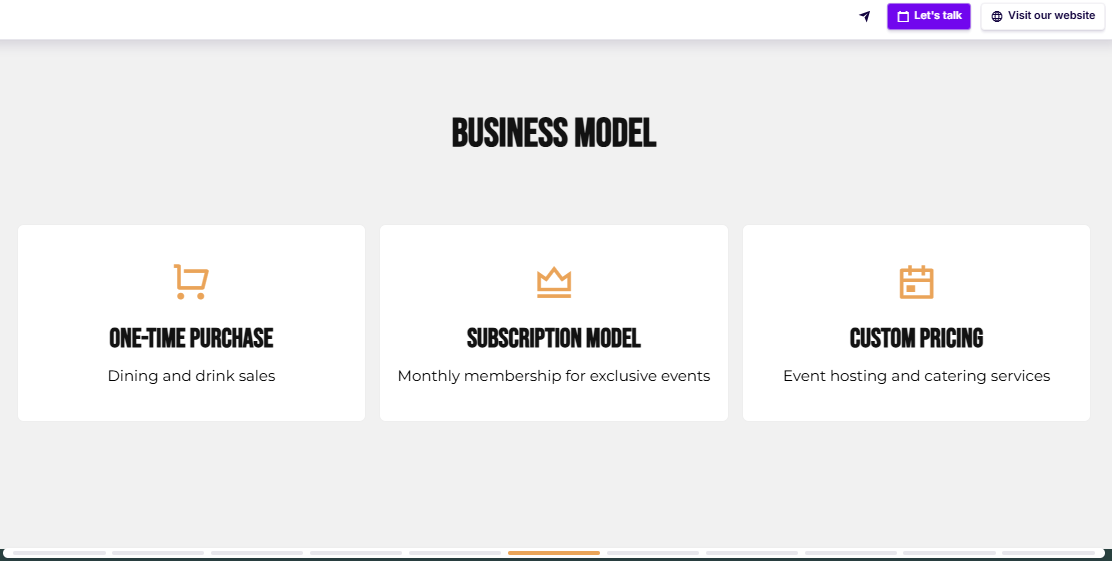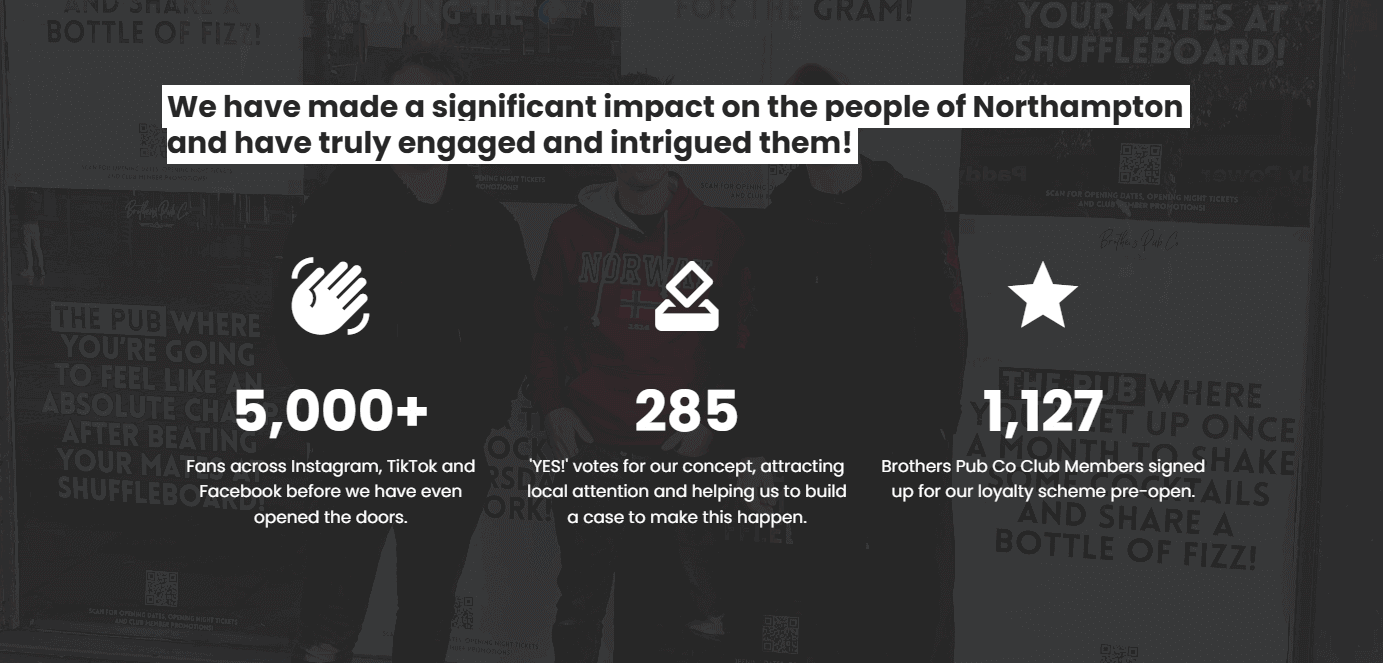How to Make a Pitch Deck for a Restaurant (+Examples)
Learn how to make a winning restaurant pitch deck, with tips on what to include in your pitch deck and customizable restaurant pitch deck examples.


Learn how to make a winning restaurant pitch deck, with tips on what to include in your pitch deck and customizable restaurant pitch deck examples.
Short answer
Scroll down to read the full guide ⤵
Who is a restaurant pitch deck for?
A restaurant pitch deck is for anyone trying to raise money to open, grow, or franchise a restaurant.
That could mean pitching to angel investors, venture capitalists, banks, family offices, or even local business partners.
The people reviewing your deck may or may not be from the food industry - so it needs to be clear, compelling, and easy to grasp whether they’ve run a kitchen or not.
What is the goal of a restaurant pitch deck?
The goal of a restaurant pitch deck is to secure investor interest by clearly presenting your concept, team, financials, and funding needs.
It should prove that your restaurant has strong market potential, a smart business model, and a clear plan for growth and return on investment.
What assets do I need before writing a restaurant pitch deck?
Before you start writing your restaurant pitch deck, pull together assets like your sample menu, logo and branding elements, high-quality food photos or mockups, and a breakdown of your concept.
You’ll also need solid financial documents: a startup cost estimate, operating budget, projected P&L, and a clear funding ask with use of funds.
For location, gather research on foot traffic, nearby competition, and rent benchmarks - even if you haven’t signed a lease yet.
And don’t forget bios of your founding team and any press, reviews, or traction you’ve already got.
What to include on your cover slide
Restaurant name and logo - Crisp and professional. Not scribbled in Canva the night before.
Tagline or concept in a sentence - Think “Modern Balkan small plates with natural wine” or “Fast-casual Indian street food for city lunches.” Keep it short and punchy.
Date - Useful if you’re sending updated versions or applying for time-sensitive funding rounds.
Visual cue - Add something that gives a feel for the brand, like a high-quality photo of your food or a mockup of the interior.
Personalization (optional) - If you know who you’re pitching, add their name or company to the slide. It’s a small touch, but it shows this isn’t the same deck you’re sending to everyone.
What to include in your executive summary
The concept - What’s the format, cuisine, and style? Is it a fine dining flagship, a scalable fast-casual brand, or a neighbourhood spot with cult potential?
Location - Where are you opening (or operating)? Why does this spot make sense?
The founder (if relevant) - If you’re a seasoned operator, trained chef, or have past success in the industry, say so. Experience goes a long way in an industry where most new restaurants fail.
The opportunity - Show that you’ve done your research. Is there unmet demand in your city? An underserved audience? A food trend you're tapping into?
Traction so far - Mention anything that proves this isn’t just an idea. Pop-up success, sold-out tastings, social following, industry praise - whatever shows people already want what you’re offering.
What to include in your market overview
Target customer profile - Who are you serving? Commuters grabbing lunch? Families on weekends? Young professionals looking for small plates and natural wine?
Local demand - Use real data where possible: foot traffic, nearby offices or universities, existing restaurant saturation, average spend per head, etc.
Market size - Zoom out slightly. How big is the addressable market in your area? How many similar concepts are thriving nearby? Remember, no one wants to invest in the 5th sushi spot on the same block.
Trends - Is your concept riding a wave (e.g. plant-based dining, craft cocktails, fast-casual reinventions)? Show how you’re tapping into it.
Why now - Highlight what makes this moment ideal to launch: a gap in the market, emerging dining trends, consumer behavior shifts, or a local real estate opportunity. Help investors see why waiting would mean missing the wave.
What to include when describing your restaurant concept
Service format - Define the model: full-service, counter-service, tasting menu, grab-and-go, etc. This influences layout, staffing, turnover, and pricing strategy.
Cuisine and sourcing - Be specific. Mention your culinary influence, signature items, or how you source ingredients. Whether you're importing from Italy or working with a local farm co-op, details like this tell people you're serious.
Guest experience - Describe the environment and flow of service. Investors should immediately understand whether this is a two-hour seated dinner or a fast lunch spot with high table turnover.
Competitive edge - Explain what makes your concept viable in your market. That could mean better price-to-quality ratio, faster service, a dish nobody else is doing, or a model that works for delivery without wrecking food quality.
Operational logic - Show that the business has been designed to work under real-world constraints. For example, a tight menu that reduces waste and simplifies prep, or a service format that runs with minimal staff during off-peak hours.
Key things to cover on your team slide
Names, roles, and headshots - Keep it simple, but professional. No blurry selfies from service.
Relevant experience - Have they worked in a high-volume kitchen? Opened other spots? Turned around a struggling bar? This is where you mention it.
Notable achievements - Awards, successful past ventures, features in the press, big-name mentors or restaurant groups - anything that builds credibility.
Why this team works - If you’ve worked together before or bring complementary strengths (e.g. one partner handles front of house, the other ops), say so.
How to structure your menu slide
Sample menu - Include a stripped-down version of your menu: a few starters, mains, and drinks. Enough to give a feel for the offering without overwhelming.
Pricing strategy - Show typical price points for each category. Explain your reasoning if needed - like sourcing premium ingredients or offering value-focused combos.
Menu design logic - Highlight how the menu supports your operations: minimal SKUs, items that use overlapping prep, dishes designed to travel well if delivery matters.
Best-sellers (if applicable) - If you’ve run a pop-up or tested the menu elsewhere, include what sold best. This shows you’re iterating based on demand - not ego.
Special items - If there’s a signature dish or something that gets people talking, include it. Especially if it helps justify pricing, press attention, or your brand story.
What to include on your business model slide
Revenue streams - Break down where the money comes from: dine-in, takeaway, delivery, private dining, catering, events, merch, alcohol, etc. The more balanced (and thought-through) your mix, the better.
Average ticket size - Estimate your average spend per customer, based on menu pricing and expected ordering patterns. Bonus points if you explain how you’ll upsell (e.g. drink pairings, add-ons, specials).
Capacity and turnover - Show how many covers you can do per service, how often you expect to turn tables, and what that means over a week/month.
Days and hours of operation - A fine-dining place open four nights a week operates very differently than a fast-casual spot open seven days from noon to 10.
Margins and cost control - Highlight how you’ll manage costs: streamlined prep, low-waste systems, portion control, smart scheduling, etc. If you’ve run the numbers and kept food/labor costs tight, show it.
Essentials to include on your location slide
Exact location (if secured) - Share the address or neighborhood, and explain why it makes sense for your format and audience.
Lease terms (if known) - Outline square footage, rent, and any key details like TI (tenant improvement) allowance, patio rights, or venting already in place.
Foot traffic and anchor spots - Mention nearby drawcards like offices, universities, theatres, gyms, or transport hubs that will feed your customer base.
Competitor context - A quick nod to similar restaurants nearby (if any), and why yours stands out. Don’t ignore competition - show how you stack up.
If you’re still scouting - Name specific neighborhoods, target square footage, and what you're looking for (e.g. second-gen space with existing infrastructure, high visibility, access to parking).
What to include on your traction slide
Pop-up or soft launch data - Sales numbers, sold-out nights, repeat customers, or waitlist stats. Anything that proves demand.
Press or social attention - Any local press mentions, influencer posts, or social media stats (followers, engagement, newsletter signups). You don’t need 50k followers - you need proof people care.
Past experience - If you’ve run other restaurants, worked under respected chefs, or helped launch other concepts, bring that credibility here.
Pre-opening buzz - Document anything happening already: RSVPs to preview dinners, collaborations with local brands, or venue partnerships.
Customer feedback - Pull quotes from people who’ve tasted your food. Even two lines from someone who drove across town for your pasta says more than a paragraph of self-praise.
What to include in your marketing and launch strategy
Pre-opening strategy - Tease your brand before the doors open: soft launches, friends-and-family nights, email signups, early loyalty perks, pop-ups, or collaborations.
Channels you’ll use - Be clear about how you’ll reach your audience: social media, local press, SEO, influencer tastings, paid ads, loyalty platforms, or good old-fashioned flyers if that fits your vibe.
Messaging and voice - Explain how your brand will speak to people. Whether it’s warm and nostalgic or bold and cheeky, consistency builds recognition.
Retention tactics - Share how you’ll keep people coming back - like SMS campaigns, loyalty programs, or limited-time offers that drive repeat visits.
What to cover on your financials slide
Startup costs - Break down what it takes to open: buildout, equipment, licenses, deposits, marketing, inventory, soft launch. Show you know what this actually costs in your city, not in theory.
Runway and burn rate - How many months of operating expenses do you need before breaking even? Show your estimated fixed and variable costs (rent, labor, food, utilities, etc.) so investors understand the timeline.
Revenue projections - Use realistic projections based on average spend, covers per day, and expected seat turnover. Tie this to your format - counter-service has different numbers than fine dining.
Profit margins - Projected food and beverage costs, labor costs, and overall net profit margins over time. (Spoiler: most investors would rather see 10% margins they believe than 20% ones they don’t.)
Timeline to break even - Be transparent. A 12–18 month runway is typical, and being upfront about how long it'll take to become self-sustaining shows maturity.
You don’t have to be an accountant - but your numbers need to hold up. Every line here should be backed by research, real-world quotes, or past experience. If you’ve got an advisor, consultant, or CFO helping, say so.
Key elements for your investment and funding slide
The ask - State clearly how much funding you're seeking. No hedging, no ranges - just the number.
Allocation breakdown - Show where the money will go. A simple pie chart or bullet list is enough: e.g. 35% buildout, 25% equipment, 15% marketing, 10% working capital, 10% licenses and fees, 5% contingency.
Timeframe - Indicate how long this funding will carry you (e.g. 12–18 months post-launch) and when you expect to break even.
Return structure - If you're offering equity, revenue share, or repayment terms, explain how it works. No need to go full term sheet - but a high-level structure helps.
Your involvement - Mention if you're personally investing or if you’ve already raised a portion. It reassures investors you’ve got something to lose, too.
How to structure your CTA slide
What you want them to do - Book a meeting? Schedule a tasting? Start due diligence? Say it clearly.
How to take that step - Add a clickable calendar link (like Calendly), contact details, or next steps button. You want zero friction.
Optional: Reaffirm the vision - A short one-liner to leave a lasting impression. Something like: “We’re not opening a restaurant. We’re building the kind of place people talk about for years.”
Socials or website (optional) - If you want to drive people to learn more, include links with custom icons that fit your brand.
Stop losing opportunities to ineffective presentations.
Your new amazing deck is one click away!




















